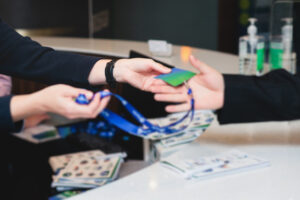RFID technology is everywhere these days, from small events to big, there’s no comparison when it comes to guest experience, responsiveness, integration, ease, security, and ROI. However, even though the technology has been around for a long time, it’s still relatively new to the events space. Traditionally used for sourcing and inventory control, RFID tags are, simply put, a message that’s received by a transmitter and tracked.
When it comes to events, the possibilities for how this individualized, segmented and trackable data can be used is nearly endless and it applies to not only events and organizers, but operations and nearly every single aspect of the industry. In this post, we’ll be covering the basics of what RFID technology is, how it works, the types you can use, what you can use it for, the pros/cons and more.
After all, there are a lot of options and we want to make sure you not only feel good about your choice, but confident in it, too.
What is RFID Technology?
Invented in 1948 by Russian scientist Leon Theremin, RFID or Radio Frequency Identification uses electromagnetic radio waves to identify, capture and transmit small amounts of data. This data is usually stored in a small RFID chip that’s embedded or attached to some sort of asset being tracked, this could be warehouse inventory, a shipping container, a concert ticket, passport, or even a pet.
In truth, it can be just about anything and its versatility is what makes RFID technology so valuable. By replacing barcodes, magnetic strips, data entry, and more, RFID offers an accurate, simple, and seamless way to collect, track and manage all sorts of real-time data, no matter the use.
Generally speaking, the only downside of RFID technology is that it does require a specific reader to track the chip and record its data. However, this doesn’t tend to be much of an issue because RFID chips can be read from a distance, making it easy to scan and read large numbers of RFID codes as they move — to get an idea, think of a large concert crowd, allowing guests to move through gates without having to individually scan tickets.
Background
RFIDs were originally developed as a supply chain tracking solution for businesses who wanted to more efficiently track their inventories. By automating data and tracking, RFIDs make it possible to tag, sort and track nearly anything, giving real-time data about what is where.
Since tags can be linked to different systems, it’s possible to put certain markers on items—like if they move—so that an alarm is triggered if it moves when it shouldn’t. Eventually, RFIDs moved from the warehouse to tracking animals, pets, passports, and cars. Before RFIDs, QR codes, barcodes, and number systems were the standard.
As you can imagine, this not only made it easy to counterfeit these materials as they’ve been around for a long time, but human error is a huge factor. After all, when dealing with massive quantities of materials or huge groups of people, it’s inevitable that something (or someone) will slip through the cracks.
3 Types of RFID Frequencies
When it comes to RFID technology, there are three types of frequencies transmitted: Low, High and Ultra-High Frequency. The main differences between the three are cost and range readability.
Low Frequency
120-150KHz, offers low data speed and a reading distance of about 1-10cm.
High Frequency
13.56MHz, offers moderate data speed and a reading distance of 1cm-1meter.
Ultra-High Frequency
902-928MHz, offers moderate to high data speed and a reading distance of 1-12 meters.
When it comes to deciding what frequency is best for your use, you want to consider the cost of the item being tracked as well as the distance as which you’ll need to ensure accuracy of scanning.
In terms of the hardware needed to run RFID technology at an event or for a business, you need two main components: The transponder or chip and the scanner or reader. Usually, RFID readers come with an interface that not only scans and tracks the data, but also forwards it to another system. The chip stores and processes the information and the antenna or reader receives and transmits the signal. Each chip has a tag that carries a specific and unique serial number for one object.
Types of RFID Tags
There are two types of RFID tags used today: Active and Passive.
Passive Tags
More economical than active tags, passive tags are the most common tag and don’t require any batteries for use. Generally used for lower and medium value items, they are wirelessly powered by the receiver and their greatest limitation is their range.
Active Tags
Active tags have batteries they draw power from so they’re bigger than a small microchip and cost more. The benefit is that their range jumps from a few meters to upwards of 100. Generally, active tags are reserved for expensive items (like cars).
- Asset tracking
- Inventory management
- Access control
- Security
- Personnel tracking
- ID badging
- Supply chain management
- Marathon timing
- ..and the list is, literally, endless
Practically speaking, RFID technology is used everyday from keyless car entry to automated toll road deductions. Even tap to pay cards, passports, and building access cards use RFIDs to track and transfer data. Because RFID technology can store more data than a bar code can, it makes it far more useful as a tracking and monitoring tool. Even better, the data can be tracked and segmented, making it possible to create highly accurate and useful insights when it comes to movement, usage, purchasing, etc.
6 Big Benefits of RFID
Making the transition to RFID technology can seem like a daunting move. However, the benefits far outweigh the costs, especially when you consider ease, efficiency and, above all, security. In fact, one of the biggest incentives when it comes to adopting RFID technology is that of touchless payments.
These transactions allow for seamless purchases, sending payments directly to your bank account with accurate reporting and settlements. Additionally, cashless and touchless transactions also mean a greater level of safety for your staff and guests. Read on for more—
1. Fast
RFID technology helps you move crowds quicker, process transactions faster, track real-time data and reduce wait times.
2. Hygienic
With less interaction, either from employees for entry, or between guests and staff for transactions, there’s less possibility of transmission. This makes running an event, office, or transaction safer than ever.
3. Sustainable
With digital receipts tracked directly to each individual (via their unique RFID tag), you produce less waste, have lower costs, and are more eco-friendly. It’s a win-win all around.
4. Transparent
With real-time reporting, vendor sales, product performance, and data are available so you can keep track, make calls, restock merchandise, and adjust as needed.
5. Secure
Counterfeit credentials, whether it’s hotel keys, ID badges, event laminates or marathon bibs are impossible to make.
6. Ease
RFID tags can be scanned from up to 12 meters away, making it easy to move large groups without having to individually see and scan each ticket, credential, or item.
While RFID is absolutely game-changing, there are some considerations. For one, its cost is higher than traditional ticketing, credentialing, and monitoring. If you’re using RFID to track products, you might want to consider if the item’s value is high enough to warrant the technology and if it’s even physically compatible. For example, can a chip be placed on or in the item without easy removal?
Integrating RFID into your event, business, hotel or office takes strategic integration. You’ll want to consider where in your supply chain, point of entry, etc. you want to incorporate an RFID tag. In addition, you’ll need to add a solution to your system for data storage. This all takes time and consideration, but the benefits of highly accurate data and tracking will likely create a far more efficient system than can make up for the costs incurred by tightening up otherwise overlooked areas.
Who are RFID Solutions For?
So far, we haven’t found an industry or event that couldn’t benefit from RFID technology. At the very least, the ability to track, monitor and collect real-time data allows you to know, without a doubt, exactly what happens, when and where at your event or on your grounds. This data makes it possible for you to make informed decisions about staffing, crowd flow, food orders and more.
Almost 60% of live event attendees list long lines as their biggest frustration at events. – MeetingPlay
We’ve also found RFID enabled credentials make traditional experiences elevated, seamless and far more enjoyable for guests. Whether a convention, office, or festival, you need to control who has access where and nothing makes that as secure, trackable, or as easy as RFID tags.
Types of RFID for Your Event / Need
RFID Wristbands
Designed for multi-day events with vendors, different access areas and more, wristbands enabled with RFID tags make it possible for your guests to have the safest, most seamless experience possible. Since attendees are already familiar with this format of credentialing, adding RFID is an easy addition. We add RFID chips by sewing them into the wristband itself, making it completely unnoticeable.

RFID Laminates
When it comes to conventions, concerts, and large-scale events, laminates are the go-to credential for bands, guests and VIP attendees. By offering the ability to fully customize your credential with art, holographic detailing and RFID technology, you can guarantee the security of your event as it’d be impossible to create a counterfeit laminate.
RFID Hard Cards
Perfect for hotels and employees, hard cards are durable credentials that make it possible to track and monitor sign-in and sign-out times, movement, and more. For guests, you can individually control access to specific areas, meals, and payments. With an embedded RFID chip, hard cards can be used and reused again and again, making them a far more sustainable choice for your hotel, event, and staff.

RFID Parking Passes & Custom Parking Tags
One of the most important parts of an event is the parking. If you can make that easy and effortless, you’ve already won over half your attendees. By using RFID technology, you can easily grant seamless and contactless entry to different parking structures and areas based on a guest’s pre-purchased parking package.
This ease of flow prevents bottlenecks, long lines and completely unnecessary traffic. Even better, with continuous and real-time tracking, you’re able to know exactly how full any one area is, making it easy to open, close, and move staff as needed..
RFID Touchless
We’ve discovered that not only are touchless solutions safer and more secure for staff and guests, but they are faster and more efficient, too. On average, attendees spend nearly 35% more with touchless payments.

RFID Racing & Timing
When it comes to race tracking, RFID is really the only way to go. With its ability to track any type of data you’d like, you can easily isolate start times, finishes, split times, and so much more. Additionally, by using RFID tags in runner’s shoes, their bibs, wristbands or other products, you can easily allow contestants to focus on their race, not their tracking.
Even better, your contestant’s friends and family can track their racer in real-time as they compete, creating a dynamic, fun and interactive experience for everyone.
RFID Gate Entry
When used at a point of entry, RFID tags make it easy for guests and attendees to use the credentials they’d already have for the event as a safe and secure means of entry. Even better, you’re able to track their movement in real-time, knowing where to send more staff to or how to better direct your guests. For staff and employees, it makes security, tracking, and access easier than ever. By using RFID at gate entry, you’re able to lower staff numbers while also eliminating the risk of counterfeit credentials.

RFID Cashless Solutions
Since RFID tags are able to track multiple points of data, isolating each, guests are able to add a payment method to their unique RFID wristband/card/etc and utilize that as their touchless payment method throughout an event. Not only does this eliminate the need for guests to carry wallets or credit cards (which may get lost), but it makes it easier at the point of sale to quickly and efficiently complete a transaction.
This is a great option for festivals, nightclubs, arenas, and anywhere else with a high volume of sales with the potential of long lines and bottlenecks. Benefits include: No contact, no wait time, real-time sales reporting; savings from carriage, increased revenue, and increased safety.

Uses & Implementation of RFID
RFID technology has become the industry standard when it comes to events, hotel security, tours, restaurants, bars, airports, and all kinds of special events. It’s easy, understood by guests and appreciated when it comes to their overall experience of your event.
pOnce you’ve decided to use RFID technology, remember it is a two part system so, while ordering your laminates, badges, and cards is something Arnett can help with, you’ll still need to make sure you have a scanner/reader. While we don’t offer them, we do work with WRSTBND, Front Gate, See Tickets, ShowClix, Intellitix and Elevate to make sure you have everything you need.
1. Timing
Be sure to budget about 3-4 weeks, from start to finish, for your credentials. Exact timing does depend on your order (including quantity), but standard turnaround time for a large event is about 30-45 business days from approval of your proof.
2. Security
Standard security features include fraud elimination, lost bands, and cashless payments. When it comes to traditional print-at-home tickets, it’s easy to duplicate them or to sell them. RFID credentials, on the other hand, can’t be duplicated because they each have a unique identification chip that cannot be copied.
Similarly for lost bands, you don’t have to worry because the previous RFID tag can be cancelled or deactivated and a new one activated. It’s that simple. And when it comes to payments, there’s no more worry about no cash, credit card, or lost cards. With secure RFID technology, guests can add their payment information to their RFID tag and tap for transactions.
3. Data
When it comes to running an event, office, or hotel, the numbers really tell the story. By understanding crowd flow, merchandise sales, inventory, and more, you’re able to better plan, order, and adjust as needed.
This helps prevent bottlenecks, running out of supplies, and knowing your clients. Also, when it comes to inventory management, your accuracy in reporting is increased by upwards of 98% from manual tracking. This includes tracking, receiving, finding items, reorders, and so much more. The potential for data gathering and usage is almost endless when it comes to RFID. It’s really up to you.
Find Your RFID Solution
While RFIDs were originally developed to quickly and wirelessly track just about anything, they’ve absolutely outgrown their first use. Today, they’re so much more than a simple inventory tracking device. They’ve revolutionized security, safety, and event management through the integration of trackability, cross-platform application, and individualization.
As one of the more exciting credentials and options available, there are new uses for RFID technology everyday, making life and events easier and more efficient than ever.
To learn more about RFID technology and what solution is best for you, get in touch with us for a custom quote by emailing [email protected].





